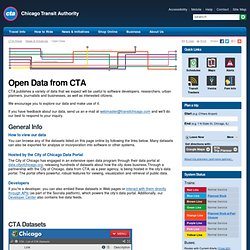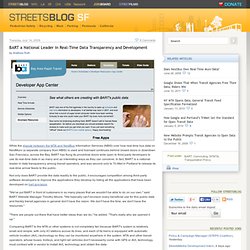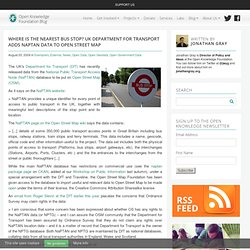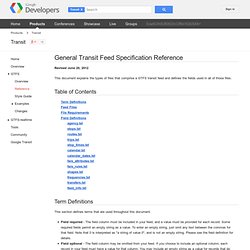

List of Public Transit Agencies on City-Go-Round. Open Data from the CTA. CTA publishes a variety of data that we expect will be useful to software developers, researchers, urban planners, journalists and businesses, as well as interested citizens.

We encourage you to explore our data and make use of it. If you have feedback about our data, send us an e-mail at webmaster@transitchicago.com and we'll do our best to respond to your inquiry. General Info How to view our data. iGov - Douglas McGray. Barack Obama has said we need a “Google for government.”

It’s a nice line, but what does it mean? Federal agencies have been online since the mid-’90s. Obama’s first crack at a Google-for-government law led to USAspending.gov, a budget tracker that looked like everything else the feds had put up on the Web—until I saw one geek-speak phrase on the home page, so small I almost missed it: API Documentation.
To understand its significance, let me tell you how I got subway schedules on my iPhone. Just a few days after Apple’s iPhone launched, a trip planner for the San Francisco Bay Area’s subway system, BART, appeared in the iTunes application store, which sells iPhone and iPod software for download. Turns out, it didn’t. “It’s not 1995,” BART’s Web-site manager, Timothy Moore, explained. A couple weeks after that first BART application appeared, a new trip planner went live. “We’ve created competition among developers,” Moore said, “to see who can serve our customers best.” BART a National Leader in Real-Time Data Transparency and Development. While the dispute between the MTA and NextBus Information Services (NBIS) over how real-time bus data on NextMuni (a separate company from NBIS) is used and licensed continues behind closed doors in downtown San Francisco, across the Bay, BART has flung its proverbial doors wide open to third-party developers to use its real-time data in as many and as interesting ways as they can conceive.

In fact, BART is a national leader in data transparency among transit operators, and was second only to Tri-Met in Portland to release its real-time arrival feeds to the public. Not only does BART provide the data readily to the public, it encourages competition among third-party software developers to improve the applications they develop by listing all the applications that have been devoloped on bart.gov/apps. "We've put BART in front of customers in so many places that we wouldn't be able to do on our own," said BART Website Manager Timothy Moore. New York Transit Data. London Transport. Swiss Transport API. Where is the nearest bus stop? UK Department for Transport adds NaPTAN data to Open Street Map. The UK’s Department for Transport (DfT) has recently released data from the National Public Transport Access Node (NaPTAN) database to be put on Open Street Map (OSM).

As it says on the NaPTAN website: > NaPTAN provides a unique identifier for every point of access to public transport in the UK, together with meaningful text descriptions of the stop point and its location. The NaPTAN page on the Open Street Map wiki says the data contains: > [...] details of some 350,000 public transport access points in Great Britain including bus stops, railway stations, tram stops and ferry terminals. This data includes a name, geocode, official code and other information useful to the project. An email from Roger Slevin at the DfT earlier this year placates the concerns that Ordnance Survey may claim rights in the data: Further details of the import agreement are available at: The NaPTAN data is currently being converted to OSM format, imported by county and merged with OSM data.
Transit. General Transit Feed Specification Reference - Transit. The arrival_time specifies the arrival time at a specific stop for a specific trip on a route.

The time is measured from "noon minus 12h" (effectively midnight, except for days on which daylight savings time changes occur) at the beginning of the service date. For times occurring after midnight on the service date, enter the time as a value greater than 24:00:00 in HH:MM:SS local time for the day on which the trip schedule begins.
If you don't have separate times for arrival and departure at a stop, enter the same value for arrival_time and departure_time. If this stop isn't a time point, use an empty string value for the arrival_time and departure_time fields. Stops without arrival times will be scheduled based on the nearest preceding timed stop. You must specify arrival and departure times for the first and last stops in a trip. Times must be eight digits in HH:MM:SS format (H:MM:SS is also accepted, if the hour begins with 0).